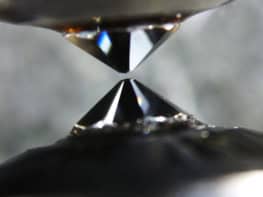
A highly sensitive instrument has picked up strong bio-fluorescence signals from fossilized organisms that perished millions of years ago. According to its developers, the new Compact Color Biofinder would be similarly handy at detecting signs of life on other planetary bodies and could therefore play a critical role in future missions by NASA and other space agencies.
Biological materials such as amino acids, proteins, lipids and even sedimentary rocks all emit bio-fluorescence signals that can be detected using special cameras. The Compact Color Biofinder, which was developed by Anupam Misra from the Hawai’i Institute of Geophysics and Planetology at the UH Manoa School of Ocean and Earth Science and Technology (SOEST), improves on these older cameras by detecting minute amounts of bio-residues that cling to rock. It can also work at a distance of several metres and scan large areas quickly.
“The first version of Biofinder was made using a large sensitive ICCD [intensified charge-coupled device] detector,” Misra says. “Since the signals from this instrument were very strong, I thought a smaller colour CMOS camera could be used. Thanks to the sensitive, low light CMOS detectors available today, this is now possible.”
Simple working principle
Biofinder’s working principle is simple, Misra tells Physics World. All bio-fluorescence has a very short lifetime of less than 20 nanoseconds, so the system first illuminates an area using an expanded pulsed laser beam with a pulse width of a few nanoseconds. The CMOS camera then takes a fluorescence image using the shortest exposure time (1 µs for the present detector). The system then waits for the next laser pulse to repeat the measurement.
“Our laser fires 20 laser pulses in one second,” Misra explains. “Hence, the system takes 20 image-frames per second and runs at video speed.” The detection limits are below ppm levels at a target distance of one metre, he adds.
Detecting bio-residue in fish fossils
In their work, which they detail in Nature Scientific Reports, Misra and colleagues studied bio-residues in fish fossils from the Green River formation, which dates from the Eocene era 56-33.9 million years ago. They found that the fossils still contain considerable amounts of residue, implying that this organic matter has not been fully replaced by minerals in the fossilization process, even after such a long time.
The team backed up the findings from the Biofinder fluorescence imagery with measurements using a range of other techniques, including Raman and attenuated total reflection Fourier-transform infrared (ATR-FIR) spectroscopies, scanning electron microscopy (SEM), energy dispersive X-ray spectroscopy (SEM-EDS) and fluorescence lifetime imaging microscopy (FLIM).
The results confirm that biological residues can survive millions of years, Misra says, and that biofluorescence imaging is effective at detecting these trace residues in real time.
“Critical in future NASA missions”
The search for life – be it existing or extinct – on other planets is a major goal for planetary exploration missions, and the researchers hope that their technology will one day become a part of missions designed to look for biomarkers on distant worlds. Indeed, they are now applying to get their instrument space qualified.

‘Mutual detectability’ will improve the search for extraterrestrial civilizations
“If the Biofinder were mounted on a rover on Mars or another planet, we would be able to rapidly scan large areas quickly to detect evidence of past life, even if the organism was small, not easy to see with our eyes, and dead for many millions of years,” Misra says. “We anticipate that fluorescence imaging will be critical in future NASA missions to detect organics and the existence of life on other planetary bodies.”
Study co-author Sonia J Rowley adds that the Biofinder’s capabilities would also be important for NASA’s Planetary Protection programme, which aims to detect contaminants such as Earth microbes on outbound spacecraft as well as any extraterrestrial biohazards that might make the return journey.



